UTS Report: Analyzing Australia's Economy & Cash Rate Recommendation
VerifiedAdded on 2023/06/13
|8
|1190
|350
Report
AI Summary
This report provides an analysis of Australia's macroeconomic environment, focusing on key indicators such as GDP growth, inflation, and unemployment rates. It examines the fluctuations and trends in these indicators over recent years and forecasts their likely performance over the next six months. The report suggests a stable increase in price levels and a slight decrease in unemployment, leading to a modest GDP growth. Based on these forecasts, the report recommends that the central bank maintain the current cash rate of 1.5% to balance economic expansion and inflation control. The analysis incorporates macroeconomic principles learned from a UTS postgraduate business course and aims to inform strategic decision-making for Australian companies amid global economic uncertainties.
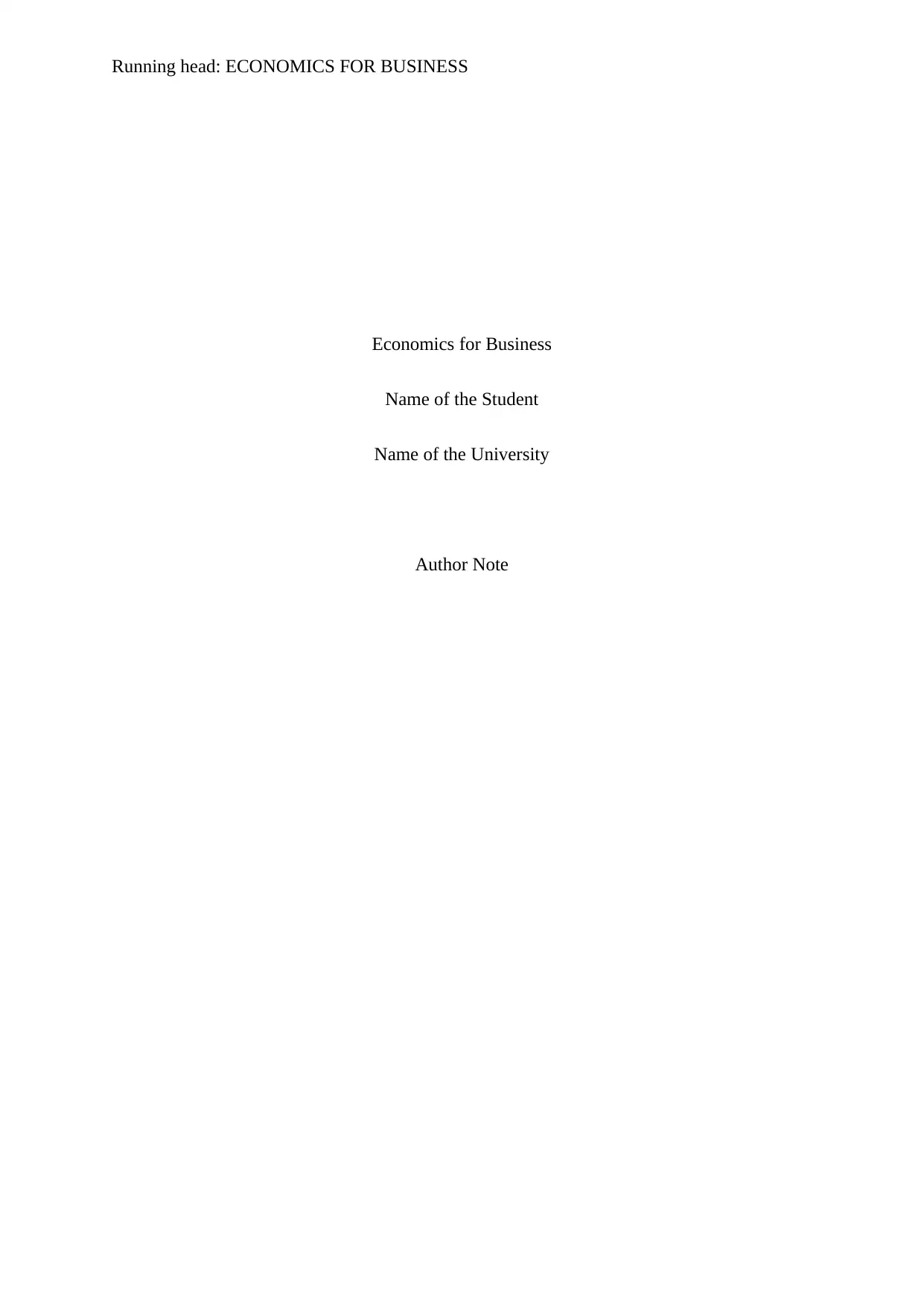
Running head: ECONOMICS FOR BUSINESS
Economics for Business
Name of the Student
Name of the University
Author Note
Economics for Business
Name of the Student
Name of the University
Author Note
Paraphrase This Document
Need a fresh take? Get an instant paraphrase of this document with our AI Paraphraser
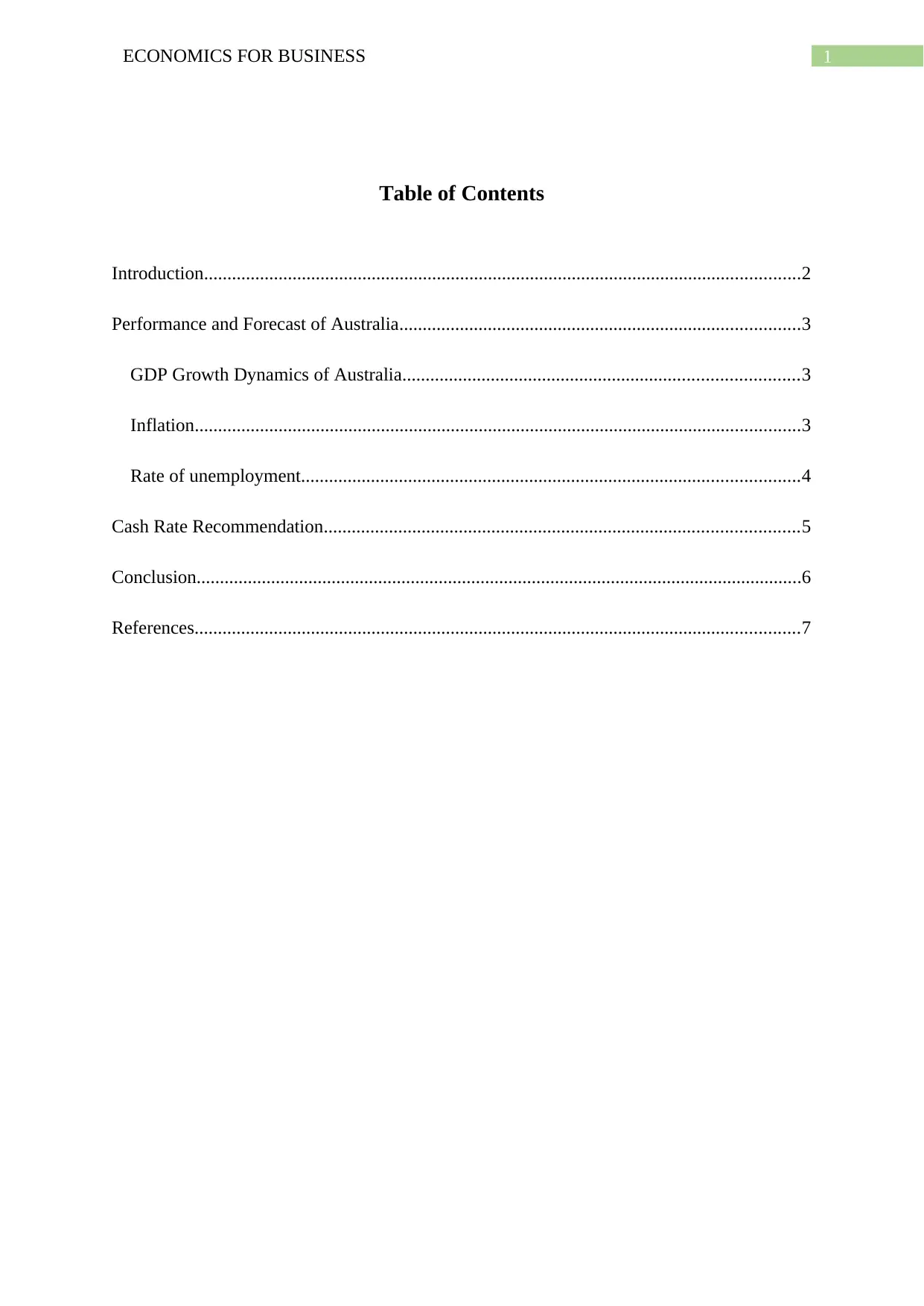
1ECONOMICS FOR BUSINESS
Table of Contents
Introduction................................................................................................................................2
Performance and Forecast of Australia......................................................................................3
GDP Growth Dynamics of Australia.....................................................................................3
Inflation..................................................................................................................................3
Rate of unemployment...........................................................................................................4
Cash Rate Recommendation......................................................................................................5
Conclusion..................................................................................................................................6
References..................................................................................................................................7
Table of Contents
Introduction................................................................................................................................2
Performance and Forecast of Australia......................................................................................3
GDP Growth Dynamics of Australia.....................................................................................3
Inflation..................................................................................................................................3
Rate of unemployment...........................................................................................................4
Cash Rate Recommendation......................................................................................................5
Conclusion..................................................................................................................................6
References..................................................................................................................................7
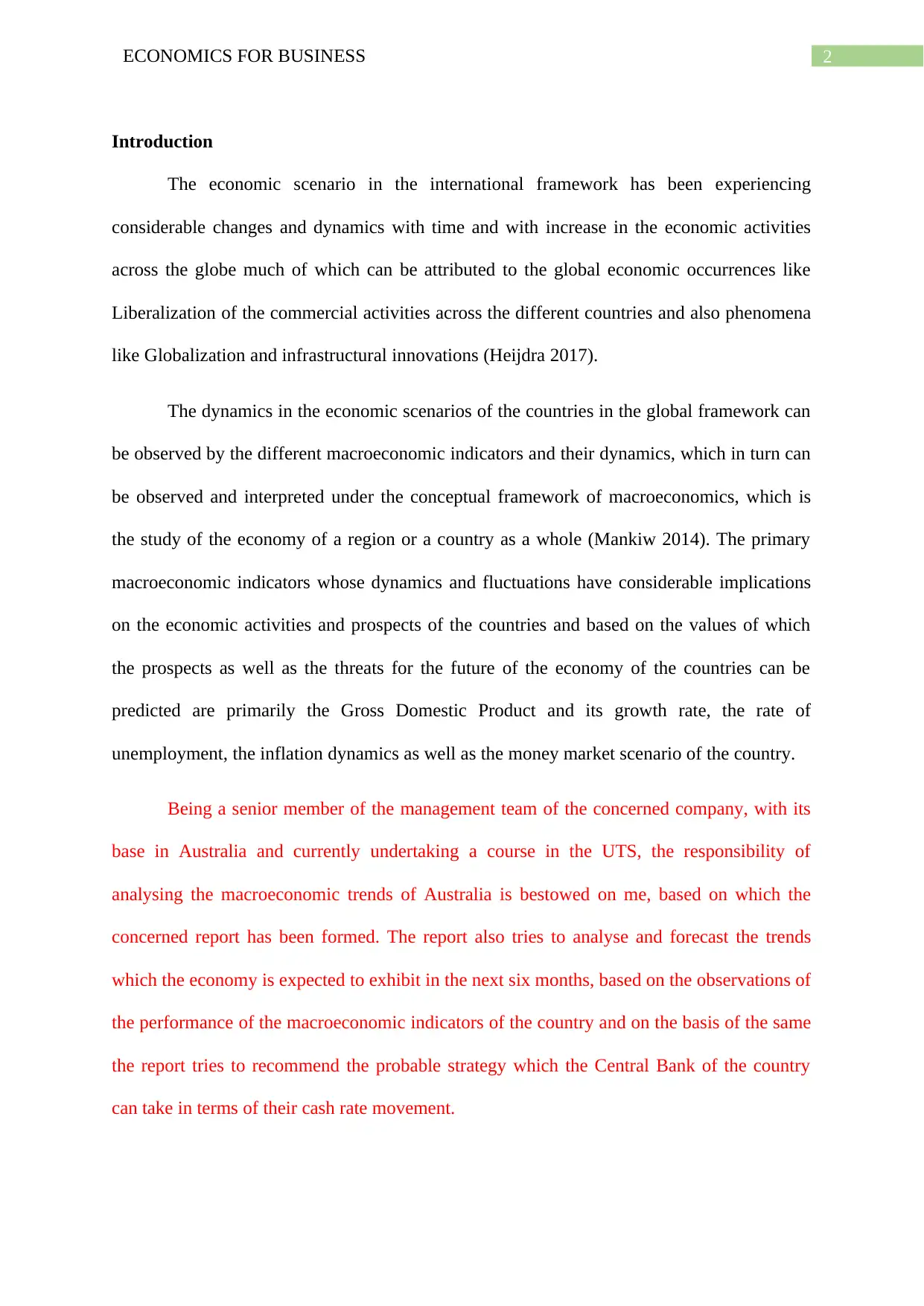
2ECONOMICS FOR BUSINESS
Introduction
The economic scenario in the international framework has been experiencing
considerable changes and dynamics with time and with increase in the economic activities
across the globe much of which can be attributed to the global economic occurrences like
Liberalization of the commercial activities across the different countries and also phenomena
like Globalization and infrastructural innovations (Heijdra 2017).
The dynamics in the economic scenarios of the countries in the global framework can
be observed by the different macroeconomic indicators and their dynamics, which in turn can
be observed and interpreted under the conceptual framework of macroeconomics, which is
the study of the economy of a region or a country as a whole (Mankiw 2014). The primary
macroeconomic indicators whose dynamics and fluctuations have considerable implications
on the economic activities and prospects of the countries and based on the values of which
the prospects as well as the threats for the future of the economy of the countries can be
predicted are primarily the Gross Domestic Product and its growth rate, the rate of
unemployment, the inflation dynamics as well as the money market scenario of the country.
Being a senior member of the management team of the concerned company, with its
base in Australia and currently undertaking a course in the UTS, the responsibility of
analysing the macroeconomic trends of Australia is bestowed on me, based on which the
concerned report has been formed. The report also tries to analyse and forecast the trends
which the economy is expected to exhibit in the next six months, based on the observations of
the performance of the macroeconomic indicators of the country and on the basis of the same
the report tries to recommend the probable strategy which the Central Bank of the country
can take in terms of their cash rate movement.
Introduction
The economic scenario in the international framework has been experiencing
considerable changes and dynamics with time and with increase in the economic activities
across the globe much of which can be attributed to the global economic occurrences like
Liberalization of the commercial activities across the different countries and also phenomena
like Globalization and infrastructural innovations (Heijdra 2017).
The dynamics in the economic scenarios of the countries in the global framework can
be observed by the different macroeconomic indicators and their dynamics, which in turn can
be observed and interpreted under the conceptual framework of macroeconomics, which is
the study of the economy of a region or a country as a whole (Mankiw 2014). The primary
macroeconomic indicators whose dynamics and fluctuations have considerable implications
on the economic activities and prospects of the countries and based on the values of which
the prospects as well as the threats for the future of the economy of the countries can be
predicted are primarily the Gross Domestic Product and its growth rate, the rate of
unemployment, the inflation dynamics as well as the money market scenario of the country.
Being a senior member of the management team of the concerned company, with its
base in Australia and currently undertaking a course in the UTS, the responsibility of
analysing the macroeconomic trends of Australia is bestowed on me, based on which the
concerned report has been formed. The report also tries to analyse and forecast the trends
which the economy is expected to exhibit in the next six months, based on the observations of
the performance of the macroeconomic indicators of the country and on the basis of the same
the report tries to recommend the probable strategy which the Central Bank of the country
can take in terms of their cash rate movement.
⊘ This is a preview!⊘
Do you want full access?
Subscribe today to unlock all pages.

Trusted by 1+ million students worldwide
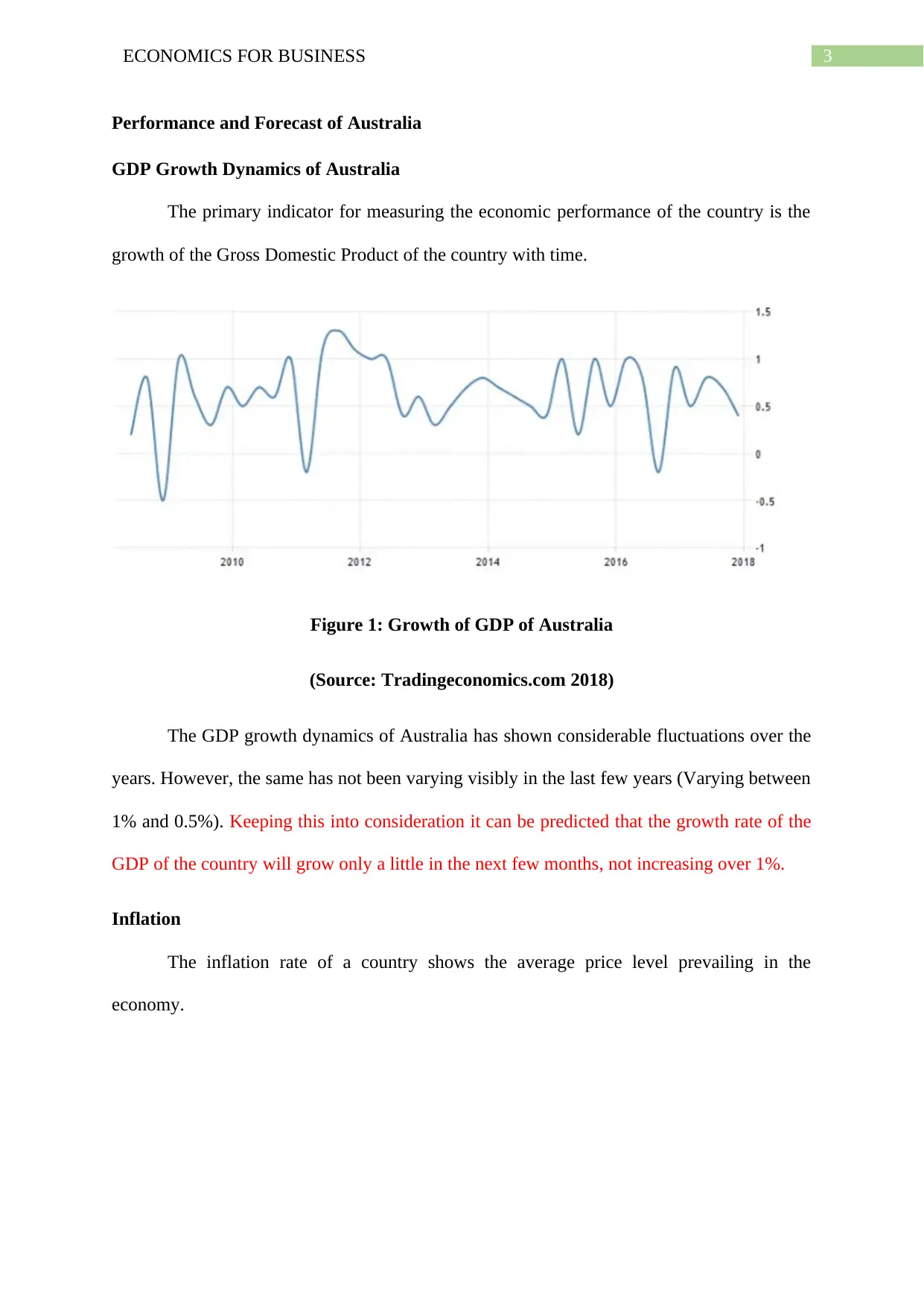
3ECONOMICS FOR BUSINESS
Performance and Forecast of Australia
GDP Growth Dynamics of Australia
The primary indicator for measuring the economic performance of the country is the
growth of the Gross Domestic Product of the country with time.
Figure 1: Growth of GDP of Australia
(Source: Tradingeconomics.com 2018)
The GDP growth dynamics of Australia has shown considerable fluctuations over the
years. However, the same has not been varying visibly in the last few years (Varying between
1% and 0.5%). Keeping this into consideration it can be predicted that the growth rate of the
GDP of the country will grow only a little in the next few months, not increasing over 1%.
Inflation
The inflation rate of a country shows the average price level prevailing in the
economy.
Performance and Forecast of Australia
GDP Growth Dynamics of Australia
The primary indicator for measuring the economic performance of the country is the
growth of the Gross Domestic Product of the country with time.
Figure 1: Growth of GDP of Australia
(Source: Tradingeconomics.com 2018)
The GDP growth dynamics of Australia has shown considerable fluctuations over the
years. However, the same has not been varying visibly in the last few years (Varying between
1% and 0.5%). Keeping this into consideration it can be predicted that the growth rate of the
GDP of the country will grow only a little in the next few months, not increasing over 1%.
Inflation
The inflation rate of a country shows the average price level prevailing in the
economy.
Paraphrase This Document
Need a fresh take? Get an instant paraphrase of this document with our AI Paraphraser
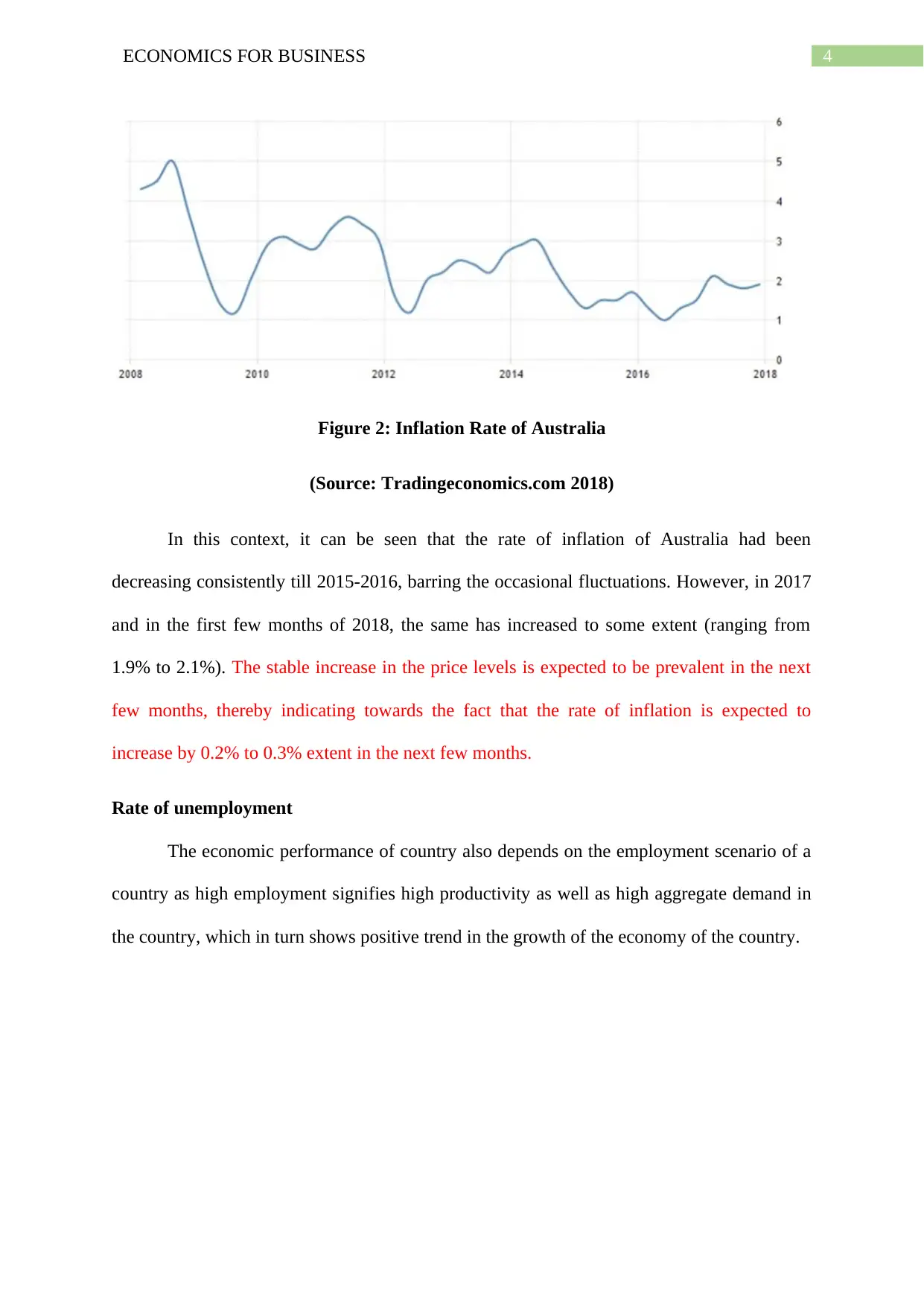
4ECONOMICS FOR BUSINESS
Figure 2: Inflation Rate of Australia
(Source: Tradingeconomics.com 2018)
In this context, it can be seen that the rate of inflation of Australia had been
decreasing consistently till 2015-2016, barring the occasional fluctuations. However, in 2017
and in the first few months of 2018, the same has increased to some extent (ranging from
1.9% to 2.1%). The stable increase in the price levels is expected to be prevalent in the next
few months, thereby indicating towards the fact that the rate of inflation is expected to
increase by 0.2% to 0.3% extent in the next few months.
Rate of unemployment
The economic performance of country also depends on the employment scenario of a
country as high employment signifies high productivity as well as high aggregate demand in
the country, which in turn shows positive trend in the growth of the economy of the country.
Figure 2: Inflation Rate of Australia
(Source: Tradingeconomics.com 2018)
In this context, it can be seen that the rate of inflation of Australia had been
decreasing consistently till 2015-2016, barring the occasional fluctuations. However, in 2017
and in the first few months of 2018, the same has increased to some extent (ranging from
1.9% to 2.1%). The stable increase in the price levels is expected to be prevalent in the next
few months, thereby indicating towards the fact that the rate of inflation is expected to
increase by 0.2% to 0.3% extent in the next few months.
Rate of unemployment
The economic performance of country also depends on the employment scenario of a
country as high employment signifies high productivity as well as high aggregate demand in
the country, which in turn shows positive trend in the growth of the economy of the country.
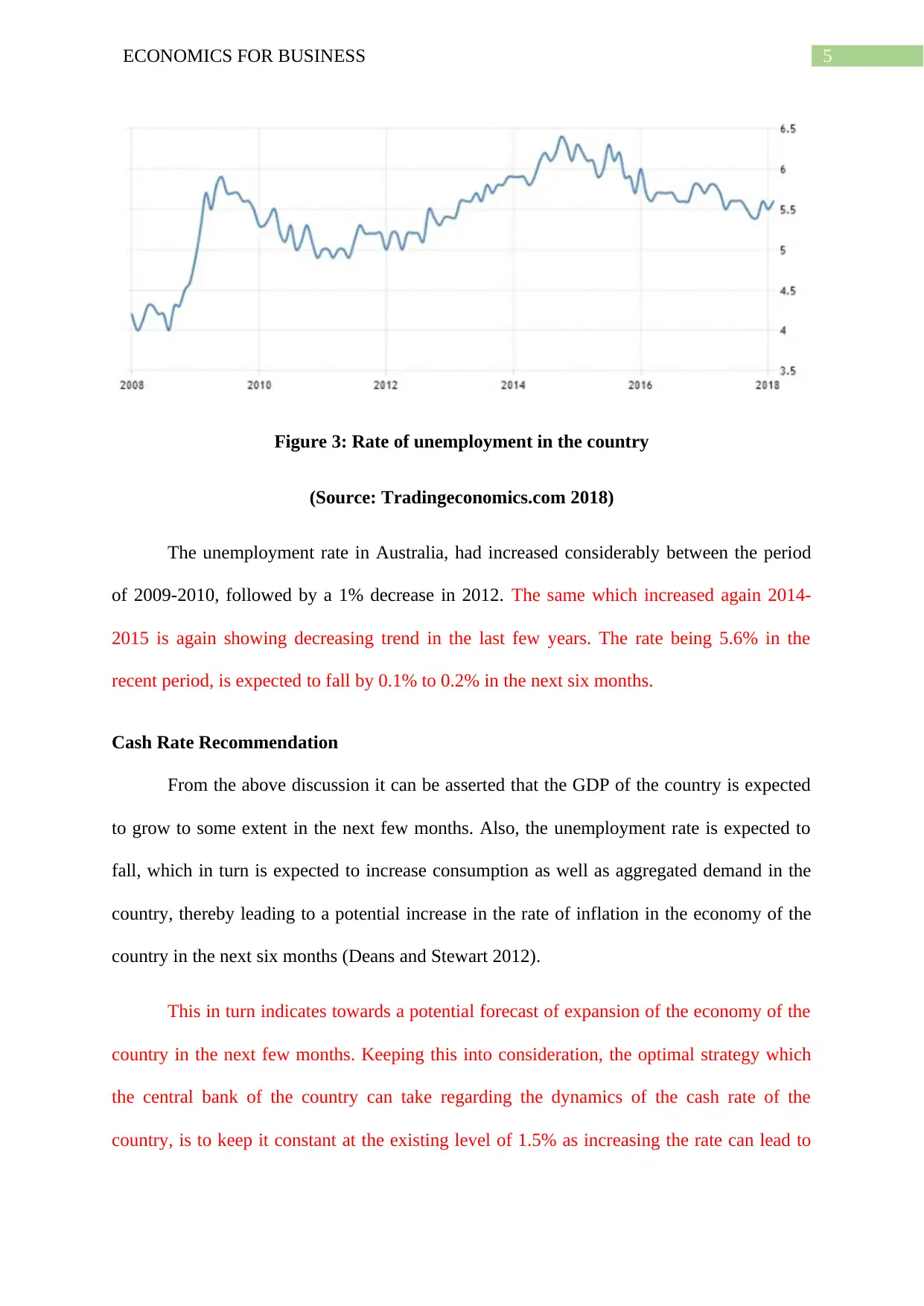
5ECONOMICS FOR BUSINESS
Figure 3: Rate of unemployment in the country
(Source: Tradingeconomics.com 2018)
The unemployment rate in Australia, had increased considerably between the period
of 2009-2010, followed by a 1% decrease in 2012. The same which increased again 2014-
2015 is again showing decreasing trend in the last few years. The rate being 5.6% in the
recent period, is expected to fall by 0.1% to 0.2% in the next six months.
Cash Rate Recommendation
From the above discussion it can be asserted that the GDP of the country is expected
to grow to some extent in the next few months. Also, the unemployment rate is expected to
fall, which in turn is expected to increase consumption as well as aggregated demand in the
country, thereby leading to a potential increase in the rate of inflation in the economy of the
country in the next six months (Deans and Stewart 2012).
This in turn indicates towards a potential forecast of expansion of the economy of the
country in the next few months. Keeping this into consideration, the optimal strategy which
the central bank of the country can take regarding the dynamics of the cash rate of the
country, is to keep it constant at the existing level of 1.5% as increasing the rate can lead to
Figure 3: Rate of unemployment in the country
(Source: Tradingeconomics.com 2018)
The unemployment rate in Australia, had increased considerably between the period
of 2009-2010, followed by a 1% decrease in 2012. The same which increased again 2014-
2015 is again showing decreasing trend in the last few years. The rate being 5.6% in the
recent period, is expected to fall by 0.1% to 0.2% in the next six months.
Cash Rate Recommendation
From the above discussion it can be asserted that the GDP of the country is expected
to grow to some extent in the next few months. Also, the unemployment rate is expected to
fall, which in turn is expected to increase consumption as well as aggregated demand in the
country, thereby leading to a potential increase in the rate of inflation in the economy of the
country in the next six months (Deans and Stewart 2012).
This in turn indicates towards a potential forecast of expansion of the economy of the
country in the next few months. Keeping this into consideration, the optimal strategy which
the central bank of the country can take regarding the dynamics of the cash rate of the
country, is to keep it constant at the existing level of 1.5% as increasing the rate can lead to
⊘ This is a preview!⊘
Do you want full access?
Subscribe today to unlock all pages.

Trusted by 1+ million students worldwide
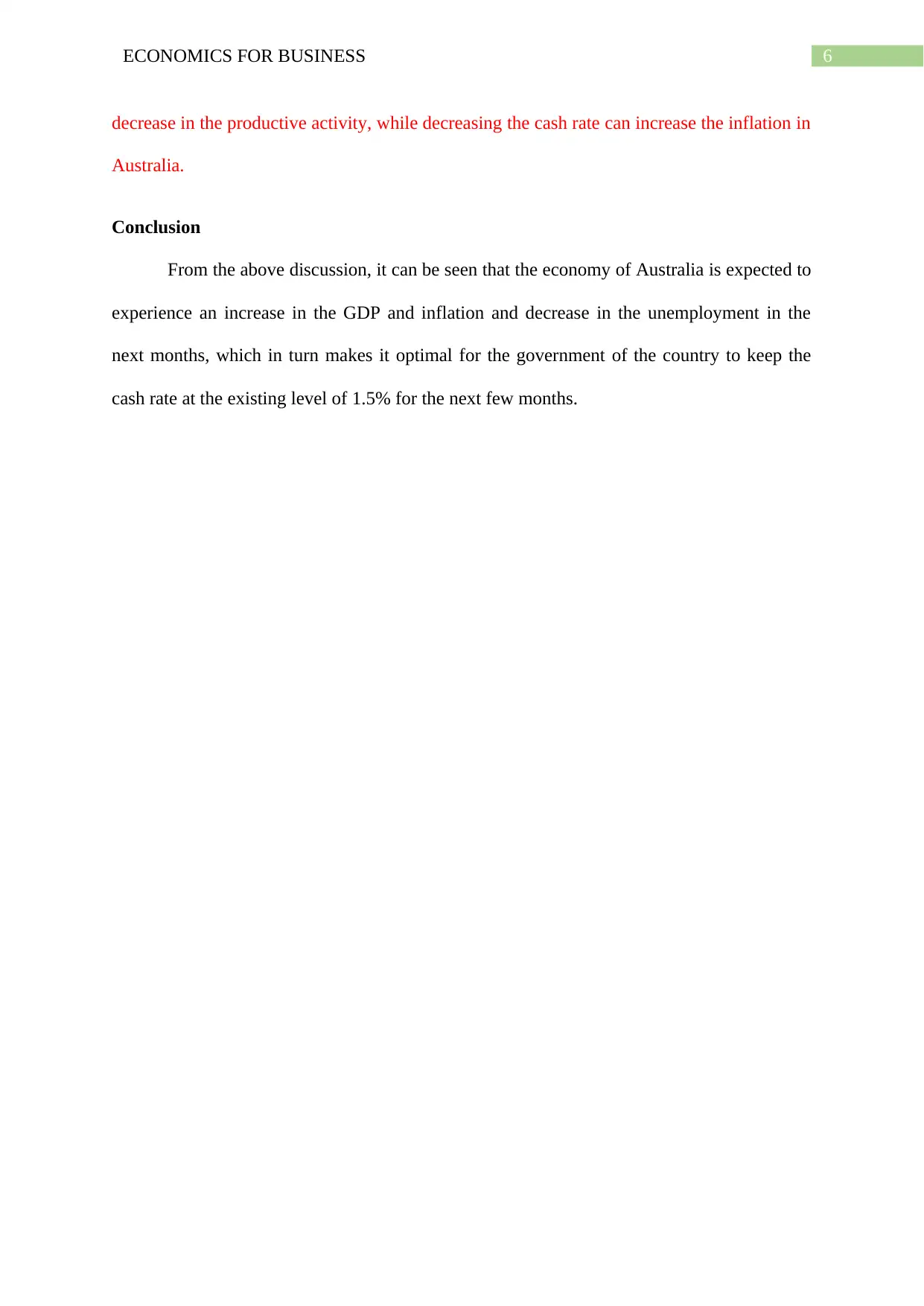
6ECONOMICS FOR BUSINESS
decrease in the productive activity, while decreasing the cash rate can increase the inflation in
Australia.
Conclusion
From the above discussion, it can be seen that the economy of Australia is expected to
experience an increase in the GDP and inflation and decrease in the unemployment in the
next months, which in turn makes it optimal for the government of the country to keep the
cash rate at the existing level of 1.5% for the next few months.
decrease in the productive activity, while decreasing the cash rate can increase the inflation in
Australia.
Conclusion
From the above discussion, it can be seen that the economy of Australia is expected to
experience an increase in the GDP and inflation and decrease in the unemployment in the
next months, which in turn makes it optimal for the government of the country to keep the
cash rate at the existing level of 1.5% for the next few months.
Paraphrase This Document
Need a fresh take? Get an instant paraphrase of this document with our AI Paraphraser
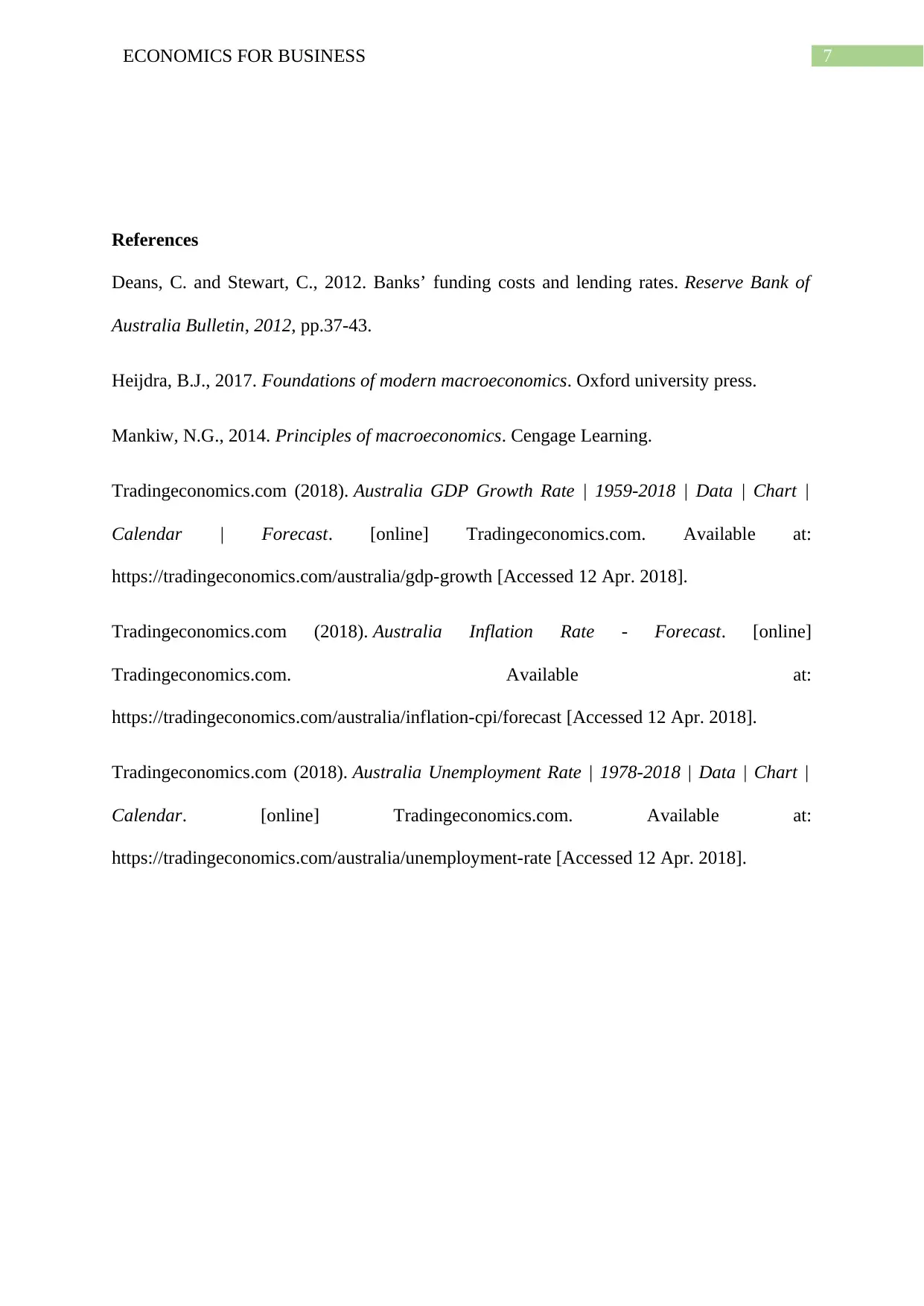
7ECONOMICS FOR BUSINESS
References
Deans, C. and Stewart, C., 2012. Banks’ funding costs and lending rates. Reserve Bank of
Australia Bulletin, 2012, pp.37-43.
Heijdra, B.J., 2017. Foundations of modern macroeconomics. Oxford university press.
Mankiw, N.G., 2014. Principles of macroeconomics. Cengage Learning.
Tradingeconomics.com (2018). Australia GDP Growth Rate | 1959-2018 | Data | Chart |
Calendar | Forecast. [online] Tradingeconomics.com. Available at:
https://tradingeconomics.com/australia/gdp-growth [Accessed 12 Apr. 2018].
Tradingeconomics.com (2018). Australia Inflation Rate - Forecast. [online]
Tradingeconomics.com. Available at:
https://tradingeconomics.com/australia/inflation-cpi/forecast [Accessed 12 Apr. 2018].
Tradingeconomics.com (2018). Australia Unemployment Rate | 1978-2018 | Data | Chart |
Calendar. [online] Tradingeconomics.com. Available at:
https://tradingeconomics.com/australia/unemployment-rate [Accessed 12 Apr. 2018].
References
Deans, C. and Stewart, C., 2012. Banks’ funding costs and lending rates. Reserve Bank of
Australia Bulletin, 2012, pp.37-43.
Heijdra, B.J., 2017. Foundations of modern macroeconomics. Oxford university press.
Mankiw, N.G., 2014. Principles of macroeconomics. Cengage Learning.
Tradingeconomics.com (2018). Australia GDP Growth Rate | 1959-2018 | Data | Chart |
Calendar | Forecast. [online] Tradingeconomics.com. Available at:
https://tradingeconomics.com/australia/gdp-growth [Accessed 12 Apr. 2018].
Tradingeconomics.com (2018). Australia Inflation Rate - Forecast. [online]
Tradingeconomics.com. Available at:
https://tradingeconomics.com/australia/inflation-cpi/forecast [Accessed 12 Apr. 2018].
Tradingeconomics.com (2018). Australia Unemployment Rate | 1978-2018 | Data | Chart |
Calendar. [online] Tradingeconomics.com. Available at:
https://tradingeconomics.com/australia/unemployment-rate [Accessed 12 Apr. 2018].
1 out of 8
Related Documents
Your All-in-One AI-Powered Toolkit for Academic Success.
+13062052269
info@desklib.com
Available 24*7 on WhatsApp / Email
![[object Object]](/_next/static/media/star-bottom.7253800d.svg)
Unlock your academic potential
Copyright © 2020–2025 A2Z Services. All Rights Reserved. Developed and managed by ZUCOL.




